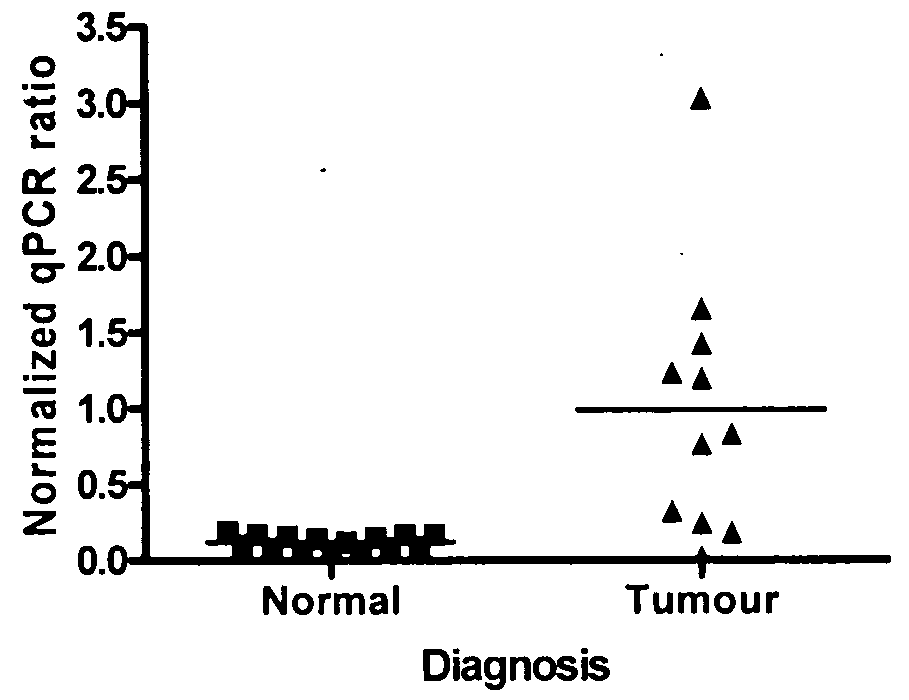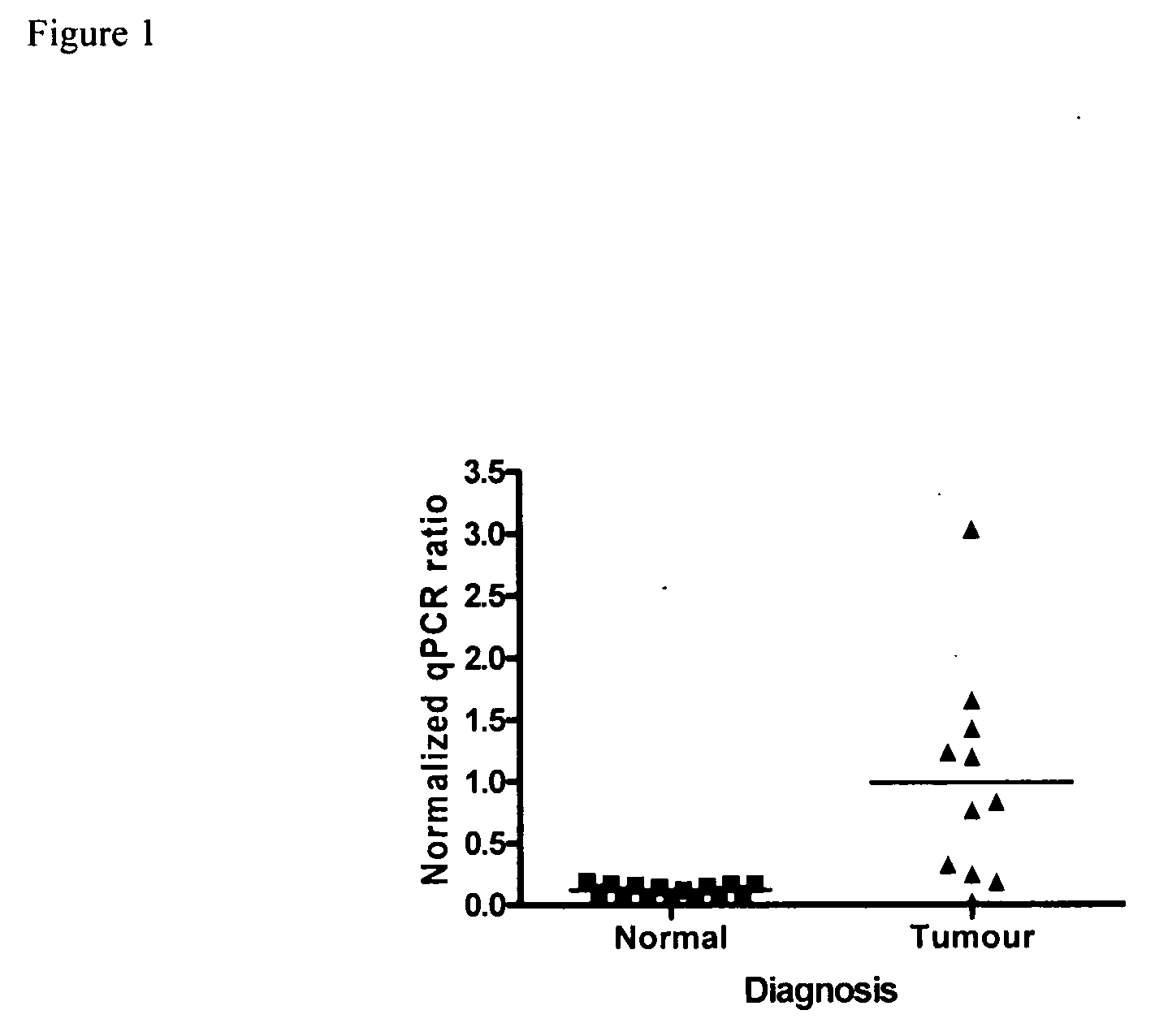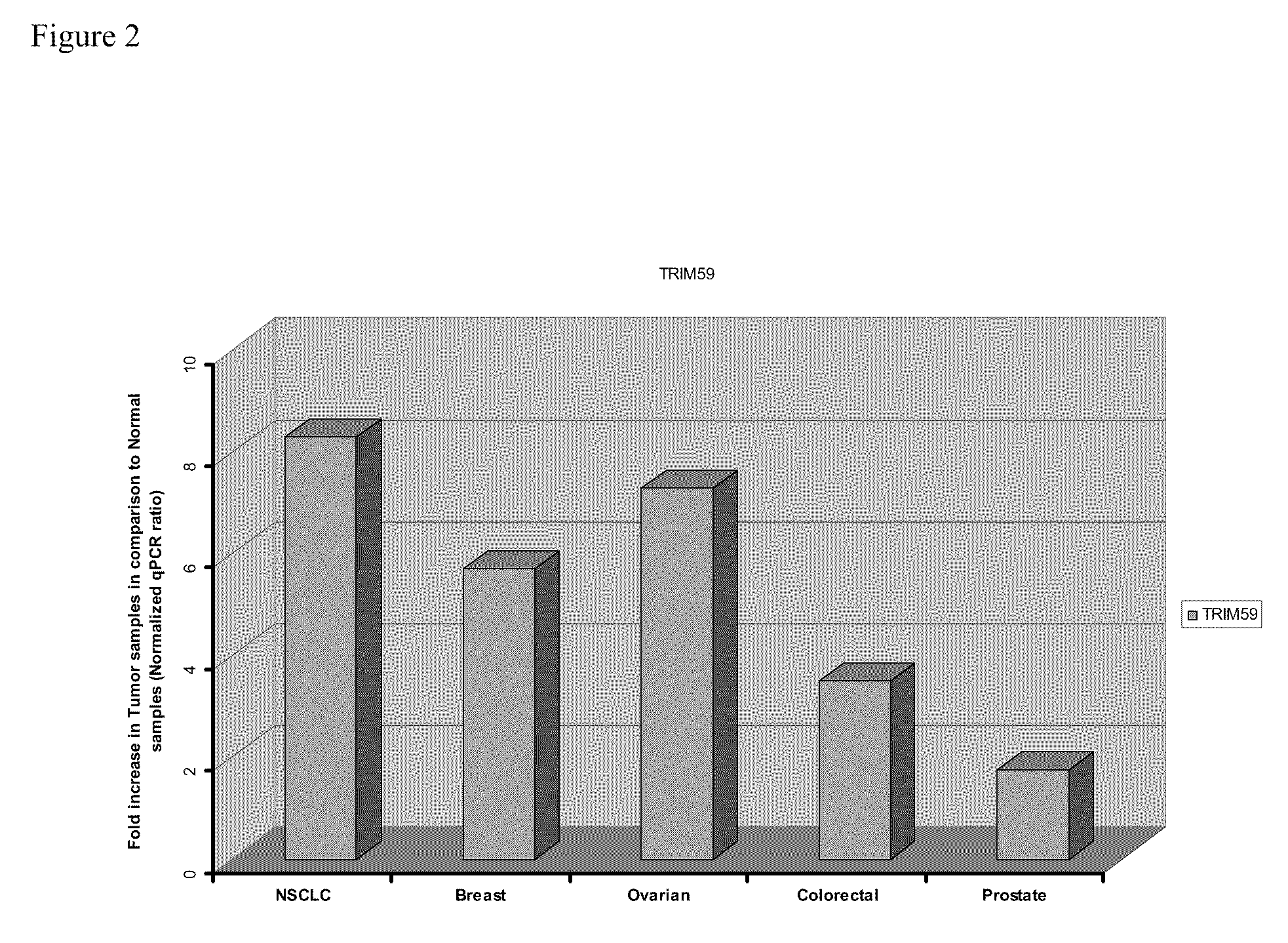Trim59 directed diagnostics for neoplastic disease
a neoplastic disease and directed diagnostic technology, applied in the field of medicine, can solve the problems of increasing the risk of cancer on the patient's life and well-being, and affecting the treatment effect of patients,
- Summary
- Abstract
- Description
- Claims
- Application Information
AI Technical Summary
Benefits of technology
Problems solved by technology
Method used
Image
Examples
example 1
Human Genome Oligoarray Experiments
1. Tumor Cell Lines
[0132]Human breast adenocarcinoma cell line MCF7, human ovarian adenocarcinoma cell line SKOV3, human ovarian carcinoma cell line 2008, human colorectal carcinoma cell lines T84 and HCT116, human lung carcinoma cell line A549, human non-small cell lung carcinoma cell line NC1-H460 and human prostatic adenocarcinoma cell line PC3 were obtained from ATCC (Manassas, Va., USA). All cell culture materials were obtained from Gibco Life Technologies (Burlington, Ont., Canada). The cell lines were cultured in αMEM medium supplemented with 10% fetal bovine serum (FBS) (MCF7) or with 15% FBS (SKOV3), in RPMI 1640 medium supplemented with 5% FBS (T84) or 10% FBS (H460) or 15% FBS (2008) or 20% FBS and 2.5% glucose, 0.1 M HEPES, 10 mM MEM sodium pyruvate and 10 μmol / ml bovine insulin (OVCAR-3), in Dulbecco's Modified Eagle Medium supplemented with 10% FBS (MDA), in McCoy's 5A Medium Modified supplemented with 10% FBS (HCT116), in HAM's F12 M...
example 2
Quantitative Real-Time PCR Assays Setup
1. Preparation of the Total RNA Calibrator
[0145]To determine the exact levels of expression of each PAN biomarker by quantitative Real-Time PCR, a calibrator cell line was used to which biomarker expression levels for each gene in patient tissues is compared to under identical reaction conditions. The calibrator was used in each experiment and allowed the comparison of different experiments. A representative range of Ct values were sought that could allow the proper quantification of each biomarker expression levels in patient samples. Preliminary experiments were done with two lung cell lines, the H23 adenocarcinoma (NSCLC) and the HFL-1 embryonic lung fibroblast cell lines. The two lung cell lines were cultured from frozen stocks in the absence of antibiotics in F-12K Nutrient mix (HFL-1 cells) or modified RPMI media (H23 cells). RNA was extracted from cells collected at various passages using the commercial RNeasy Mini Kit (Qiagen, USA). Gen...
example 3
Validation of the PAN Biomarkers in Clinical Samples
[0150]Five different groups of patients were studied. The lung cancer group consisted of non-small cell lung cancer (NSCLC) patients with a variety of subtypes (mainly adenocarcinomas and squamous cell carcinomas. Patients within the lung cancer group had an average age of 62.5 years and were mostly male. Early disease stages were well represented (I-II) (with only one stage III patient) in this group samples. The Breast Cancer Group was of an average age of 53.1 years with a majority of Caucasian women. Stages I and II breast cancer are equally represented in this group, as well as the women menopausal status. For the breast cancer patients, the majority of the cases were infiltrating ductal carcinoma. The Ovarian Cancer Group of patients was of an average age of 61.5 and patients diagnosed with serous adenocarcinomas stage III, mostly menopausal. The Colorectal Cancer Group, patients were only males with an average age of 69.7 ye...
PUM
| Property | Measurement | Unit |
|---|---|---|
| Mass | aaaaa | aaaaa |
| Mass | aaaaa | aaaaa |
| Level | aaaaa | aaaaa |
Abstract
Description
Claims
Application Information
 Login to View More
Login to View More - R&D
- Intellectual Property
- Life Sciences
- Materials
- Tech Scout
- Unparalleled Data Quality
- Higher Quality Content
- 60% Fewer Hallucinations
Browse by: Latest US Patents, China's latest patents, Technical Efficacy Thesaurus, Application Domain, Technology Topic, Popular Technical Reports.
© 2025 PatSnap. All rights reserved.Legal|Privacy policy|Modern Slavery Act Transparency Statement|Sitemap|About US| Contact US: help@patsnap.com



